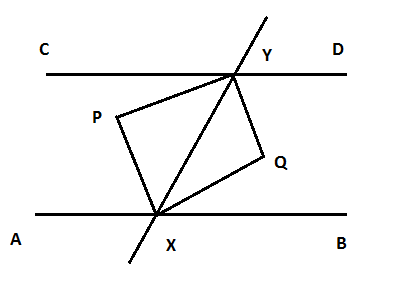Answer
400.8k+ views
Hint: Make a rough diagram that shows the situation given in the question. Then use the properties of parallel lines and transversal lines to prove that opposite sides are parallel (of the rectangle) and that the interior angles are right angles.
Complete step by step solution:
Consider: AB and CD are 2 parallel lines selected by a transversal L. X and Y are the point of intersection of L with AB and CD respectively. ХP,XQ,YP and YQ are the angle bisectors of angles $\angle AXY,\angle BXY,\angle CYX$ and $\angle DYX$

To prove:
The figure obtained on going YP, YQ, XP, XQ is a rectangle or PXQY is a rectangle.
Proof:
As $AB\parallel CD$ and line L is a transversal.
$\therefore \angle AXY=\angle DYX$ (pair of alternate angle)
$\Rightarrow \dfrac{1}{2}\angle AXY=\dfrac{1}{2}\angle DYX$
$\Rightarrow {{\theta }_{1}}={{\theta }_{4}}$ as $\left( {{\theta }_{1}}=\dfrac{1}{2}\angle AXY\text{ and }{{\theta }_{4}}=\dfrac{1}{2}\angle DYX \right)$
This implies that$PX\parallel YQ$. …….. 1
($\because $ if a transversal intersects two lines in such a way that a pair of alternate interior angles are equal, then two lines are parallel.)
Now, $\angle BXY=\angle CYX$ (pair of interior angle)
$\Rightarrow \dfrac{1}{2}\angle BXY=\dfrac{1}{2}\angle CYX$
$\Rightarrow {{\theta }_{2}}={{\theta }_{3}}$ as $\left( {{\theta }_{2}}=\dfrac{1}{2}\angle BXY\text{ and }{{\theta }_{3}}=\dfrac{1}{2}\angle CYX \right)$
This further implies that PY is parallel to XQ ….. 2
(if a transversal intersects two lines in such a way that a pair of internal angles alternate to each other are equal, then two lines are parallel).
From 1 and 2 we get,
PYXQ is a parallelogram
(as the opposite sides are parallel to each other)
$\angle CYD=180{}^\circ $
$\dfrac{1}{2}\angle CYD=90{}^\circ $
$\Rightarrow \dfrac{1}{2}\left( \angle CYX+\angle DYX \right)=90{}^\circ $
$\Rightarrow {{\theta }_{3}}+{{\theta }_{4}}=90{}^\circ $
$\Rightarrow \angle PYQ=90{}^\circ $
Also,${{\theta }_{3}}={{\theta }_{1}}$
${{\theta }_{4}}={{\theta }_{2}}$
$\Rightarrow {{\theta }_{3}}+{{\theta }_{4}}={{\theta }_{1}}+{{\theta }_{2}}=90{}^\circ $.
Hence, PYQX is a rectangle.
Hence proved.
Note: Alternate angles are the two angles formed when the line crosses two other lines that lie on the Opposite sides of the transversal line and on opposite relative sides of the other lines.
Complete step by step solution:
Consider: AB and CD are 2 parallel lines selected by a transversal L. X and Y are the point of intersection of L with AB and CD respectively. ХP,XQ,YP and YQ are the angle bisectors of angles $\angle AXY,\angle BXY,\angle CYX$ and $\angle DYX$

To prove:
The figure obtained on going YP, YQ, XP, XQ is a rectangle or PXQY is a rectangle.
Proof:
As $AB\parallel CD$ and line L is a transversal.
$\therefore \angle AXY=\angle DYX$ (pair of alternate angle)
$\Rightarrow \dfrac{1}{2}\angle AXY=\dfrac{1}{2}\angle DYX$
$\Rightarrow {{\theta }_{1}}={{\theta }_{4}}$ as $\left( {{\theta }_{1}}=\dfrac{1}{2}\angle AXY\text{ and }{{\theta }_{4}}=\dfrac{1}{2}\angle DYX \right)$
This implies that$PX\parallel YQ$. …….. 1
($\because $ if a transversal intersects two lines in such a way that a pair of alternate interior angles are equal, then two lines are parallel.)
Now, $\angle BXY=\angle CYX$ (pair of interior angle)
$\Rightarrow \dfrac{1}{2}\angle BXY=\dfrac{1}{2}\angle CYX$
$\Rightarrow {{\theta }_{2}}={{\theta }_{3}}$ as $\left( {{\theta }_{2}}=\dfrac{1}{2}\angle BXY\text{ and }{{\theta }_{3}}=\dfrac{1}{2}\angle CYX \right)$
This further implies that PY is parallel to XQ ….. 2
(if a transversal intersects two lines in such a way that a pair of internal angles alternate to each other are equal, then two lines are parallel).
From 1 and 2 we get,
PYXQ is a parallelogram
(as the opposite sides are parallel to each other)
$\angle CYD=180{}^\circ $
$\dfrac{1}{2}\angle CYD=90{}^\circ $
$\Rightarrow \dfrac{1}{2}\left( \angle CYX+\angle DYX \right)=90{}^\circ $
$\Rightarrow {{\theta }_{3}}+{{\theta }_{4}}=90{}^\circ $
$\Rightarrow \angle PYQ=90{}^\circ $
Also,${{\theta }_{3}}={{\theta }_{1}}$
${{\theta }_{4}}={{\theta }_{2}}$
$\Rightarrow {{\theta }_{3}}+{{\theta }_{4}}={{\theta }_{1}}+{{\theta }_{2}}=90{}^\circ $.
Hence, PYQX is a rectangle.
Hence proved.
Note: Alternate angles are the two angles formed when the line crosses two other lines that lie on the Opposite sides of the transversal line and on opposite relative sides of the other lines.
Recently Updated Pages
The branch of science which deals with nature and natural class 10 physics CBSE

The Equation xxx + 2 is Satisfied when x is Equal to Class 10 Maths

Define absolute refractive index of a medium

Find out what do the algal bloom and redtides sign class 10 biology CBSE

Prove that the function fleft x right xn is continuous class 12 maths CBSE

Find the values of other five trigonometric functions class 10 maths CBSE

Trending doubts
Difference between Prokaryotic cell and Eukaryotic class 11 biology CBSE

Difference Between Plant Cell and Animal Cell

Select the word that is correctly spelled a Twelveth class 10 english CBSE

Fill the blanks with the suitable prepositions 1 The class 9 english CBSE

What is the z value for a 90 95 and 99 percent confidence class 11 maths CBSE

Give 10 examples for herbs , shrubs , climbers , creepers

What organs are located on the left side of your body class 11 biology CBSE

What is BLO What is the full form of BLO class 8 social science CBSE

Change the following sentences into negative and interrogative class 10 english CBSE



